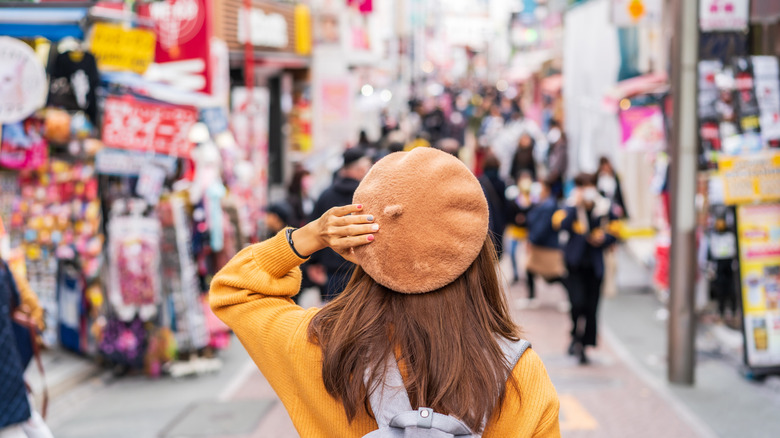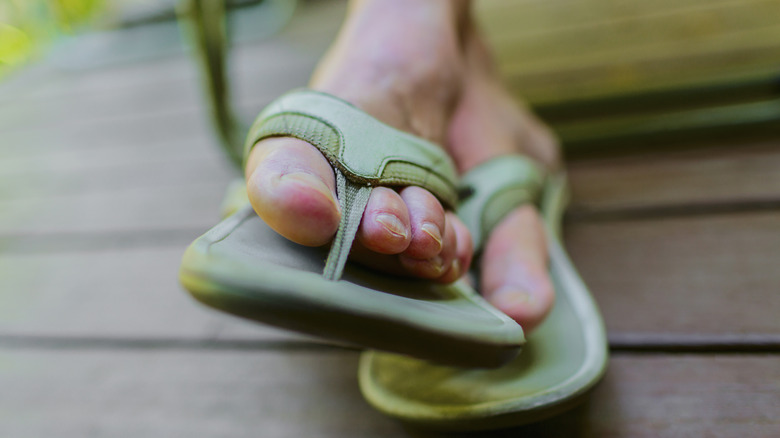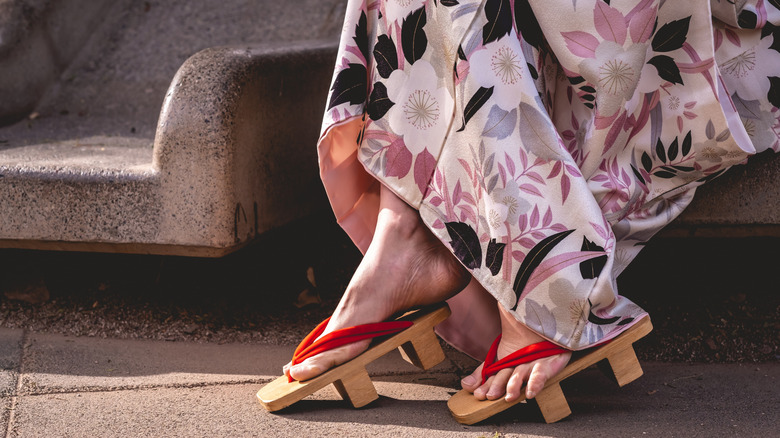The Footwear Faux Pas That That Will Make Any Tourist Stand Out In Japan
Just what is it that makes Japan so magical? The Land of the Rising Sun is one of the hottest destinations on the planet right now, with visitors flocking to the archipelago to dive into its incredible culture, mouth-watering cuisine, and host of outdoor gems, such as this pristine, underrated national park in Hokkaido. While Japan is a gorgeous, fascinating country with seemingly something for everyone, it's also governed by a set of unspoken rules, so it pays to educate yourself about how to be a considerate tourist before you go. For example, always take your shoes off before entering a private residence and try to remain silent on trains and public transportation to avoid disturbing others — this is an important way to be respectful.
These rules also extend to the things we wear. While the Japanese are often seen as being on the cutting edge of fashion trends, they also frown upon certain choices such as plunging necklines that show off too much cleavage, short-shorts, overly ripped jeans, garish colors and patterns, athletic wear outside of the gym, and wearing flip-flops on the street. That's right, those ubiquitous toe-splitting sandals that are the default footwear for so many in Western countries aren't really worn outside of the beach in Japan. So before you pack open-toed sandals, here's what to know about this footwear faux pas that tourists often make.
Why it's best to cover up your toes in Japan
While you certainly won't be scolded for wearing flip-flops in public, it is considered impolite, and you may be quietly judged or even subjected to a few uncomfortable glances. Flip-flops aren't designed for long walks anyway, and since you'll likely be doing a lot of ambulating during your time in the country, comfortable shoes that you can easily slip on and off are probably your best bet.
Another reason — aside from standing out as an obvious tourist — why flip-flops aren't a good choice in Japan, is the fact that they're not really suitable for use on public transportation. For example, the Tokyo metro system is one of the best in the world, and you'll surely find yourself riding the subway during any visit to the capital. It can also get incredibly crowded, which means people will easily step on the back of your flip-flops, and perhaps your unprotected toes as well, so it's best to keep everything covered up.
Japan's interesting history of open toed footwear
It's not as if Japanese people don't own flip-flops. They'll certainly slip them on at the beach and will often wear them to walk around their balconies and yards. You may even see someone in sandals making a quick trip to their local store, but they're not seen as everyday footwear appropriate to wear in public.
This is interesting, as some argue that the modern flip-flop was actually invented in Japan. While people around the world have been wearing thonged sandals for thousands of years, the zori — a flip-flop-like shoe traditionally worn by children in Japan — was brought to the U.S. by American soldiers after World War II. It caught on as a comfortable and useful piece of footwear with surfers and housewives, and spread from there.
There is another Japanese predecessor to the flip-flop known as geta. These elevated wooden sandals are almost always worn with a kimono and Japanese people may don them at a hot spring resort — like this cozy onsen town surrounded by mountains. This all means that the Japanese aren't afraid to bare their feet in public, but only in certain situations. If you do plan to visit a Japanese hot spring, make sure to familiarize yourself with these etiquette rules.


